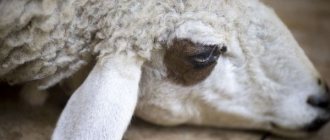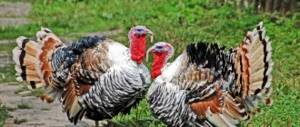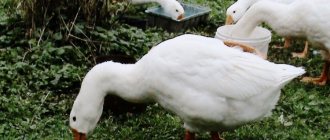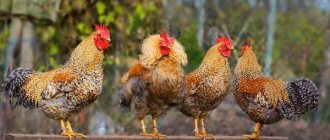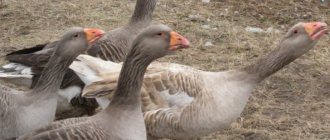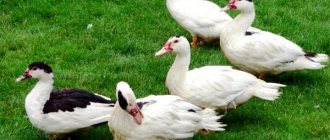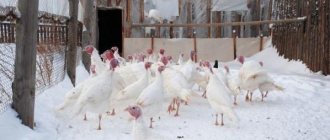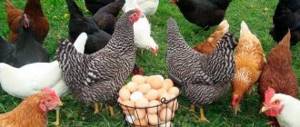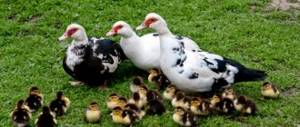The main differences between the BIG breeds
The BIG-6 and BIG-9 breeds were bred by breeders in the UK. They are large farm birds. A characteristic feature is a wide chest, a small head and light plumage.
The white color of the feather is the calling card of these breeds; dark areas can only be found on the chest. Only a small area has a dark color. The feathers of these turkeys are light and shiny. It is famous for its excellent thermal insulation properties. Turkey feathers are used in textiles and light industry. It is used with great success to produce blankets, down jackets, sleeping bags and other textiles.
It is noteworthy that BIG-9 and BIG-6 turkeys are fluffier than the females of these varieties. Males are distinguished among the flock by their proud gait and wide, even back. The muscles on the sternum are clearly expressed and have a convex structure. A farmer who plans to breed these large birds should be aware of one feature.
These breeds have fairly strong, massive wings. Despite the fact that they weigh quite a lot, turkeys can easily fly over a fence three to five meters high. In order to prevent escapes from the poultry house while walking in the fresh air, it is recommended to trim several rows of the primary wings of birds.
About
Turkey breed Hybrid Converter
This is a heavyweight and meaty cross. The characteristics of this type indicate the profitability of the product and its high performance in the market. The white and wide chest is the main incomparable advantage of the turkey, and the Big-6 cross has the same.
An adult male can reach a weight of 24 kg, and a female - 11 kg. Meat precocity and excellent quality of meat are also the main advantages.
Hybrid Converter was developed by crossing Bronze Broadbreasted Turkeys with Dutch Turkeys. The Hybrid company became famous in 1954 due to the active breeding of this species. Today, this organization occupies a leading position throughout the globe.
Keeping turkeys
Big turkeys are one of the largest poultry. In size they are second only to ostriches. It is quite obvious that such massive birds must be kept separately from other individuals.
Close proximity to other poultry such as chickens, geese and ducks, or farm animals can cause unwanted conflicts. To avoid this, it is better to fence off the place where the bird family walks and lives from other birds.
It is also better to house big males separately from females. During the mating period, these large birds can behave extremely aggressively and cause harm to females and chicks.
The big turkey family consists of one male and five to seven females. The male is ready for mating after reaching sexual maturity - about six to eight months after birth. Laying hens are ready to lay eggs after seven to eight months.
Nests can be built for one female or for four or five. During the season, one female can lay about eighty large eggs. The average weight of a female is twelve to fifteen kilograms, the male is almost twice as large and weighs about twenty-five kilograms.
Distinctive features of turkeys
The most striking feature of the But-8 turkeys that describes this breed is their decorative appearance.
Lush snow-white plumage combined with a gracefully arched neck, a large bright red nose with a characteristic red beard - such turkeys will stand out against the background of a gray poultry yard. Large paws, supporting the stability of the massive body, complete the description of these beautiful domestic birds. Diet for turkey poults
A medium-sized bird of the Byut-8 breed belongs to the big category; an adult male (after 32 weeks) weighs 27 kg, and a female – 10 kg. To achieve such significant weight indicators, big turkey poults representing the But-8 breed require a special feeding regimen: To gain 1 kg of weight at different ages, the But-8 bird breed needs:
- Up to 17 weeks of age - 2.2 - 2.44 kg of feed.
- After 17 weeks of age - 2.5 -2.95 kg of feed.
- After 20 weeks of age -3.2-3.42 kg of feed.
Turkeys are fed with mixed feed or feed mixtures.
How it works – Turkey Breeding
Breeding turkeys of the BIG breed on home farms
To make a profit from raising turkeys, you need to take care of creating comfortable conditions for them. Chicks must be kept in a separate house. For them you need to create a special temperature regime.
The temperature should not be lower than twenty-five to thirty degrees in the first days of life. Birds should be fed at least eight to ten times a day.
The diet should include as much protein as possible. It is vital for birds in the early stages of life in order for the bone skeleton to form correctly and as a preventive measure for diseases of the musculoskeletal system.
The fact is that turkeys of the BIG-6 and BIG-9 varieties are very large in size, respectively, the entire weight load falls on the bone skeleton and muscle corset.
Chicks that do not receive additional calcium and protein food at an early age may lag significantly behind their peers in development. It is better to cull such chicks with noticeable underweight immediately. They will be of no use; in the future they will gain body weight poorly and are unlikely to be suitable for slaughter.
BIG 9
The British one has many achievements. One of them relates to the creation of heavy-cross turkeys BIG 9. Externally, the birds resemble BIG 6 individuals. The plumage of individuals is white and voluminous. There is a small dark spot on the chest. The skin on the head is red, there is also a blue tint, but not much of it.
More on the topic: Why is a turkey’s liver stained after it’s been killed?
The stance of BIG 9 turkeys is lower than that of BIG 6. The physique is distinguished by high muscle mass. The lower limbs are widely spaced. Breeders worked not only on the accelerated growth of young animals, but also on the high egg production of females:
- the average weight of a newborn turkey is 60 g;
- at 2 months, the turkey’s body weight increases to 17 kg, but the young continue to grow;
- at 3 months you can get a carcass weighing 22 kg from a bird;
- turkeys do not weigh as much as males. At 3 months their weight can be 11 kg. The females form a separate herd. They are raised for their eggs;
- Puberty in turkeys begins at 7 months. They lay their first clutch at 9 months. In a year, a turkey lays up to 118 eggs. This is more than the females of the BIG 6 cross give;
- Fertility rate 90%. Chick survival rate is 83%.
Newborn turkey poults are placed under brooders on litter. The optimal temperature in the enclosure is 35 C, humidity 80%, daylight hours 24 hours. Starting from 2 weeks, the chickens’ regime is changed: the temperature is lowered and the daylight hours are reduced. After a month, the room with turkey poults is kept at an air temperature of 21 C and a humidity of 60%. Length of day 16 hours.
In large poultry farms, turkeys are kept on bedding: it is made from wood shavings. The bird is sleeping, sitting on the floor covering. They don’t make perches for her. Garbage is removed from the enclosure every day. The bedding is changed during a technical break, when the young animals are sold for meat.
Turkeys Big 9
Feeders for dry food and hay are installed in the enclosure. The drinking bowls have a nipple design. For turkey poults, baths with ash and sand are installed so that they clean the plumage of excess fat and insects. As a preventive measure against infections, individuals are regularly given a solution of potassium permanganate and vitamin cocktails.
More on the topic: How to fatten turkeys for meat?
Turkeys are kept separately from males. An enclosure will also be organized for them. It is divided into 2 parts. All equipment is located on the stern platform. Nests are organized on the opposite side. Each nest is a voluminous box with blank walls. The number of nests should correspond to the proportion of 1/3: for every 3 laying hens there is 1 nest.
When breeding turkeys of heavy crosses in households, homesteaders build poultry houses with perches for them. Strong planks of 5*5 cm are provided as perches. The length of the perch for 1 individual is 60 cm. The structures are installed at a height of 40 cm.
In winter, the bird is kept indoors, but is regularly walked in an open enclosure. Turkeys tolerate cold well. Cross is highly adaptable to climatic conditions. In the summer, the livestock are housed in pens and walked on pastures.
Igor Nikolaev
auto RU
A distinctive feature of the BIG 9 bird is that males show good productivity, both when fed with dry mixtures and with traditional nutrition, but it must be properly organized. Grain mixtures, which necessarily include soybeans and corn, are used as feed. Turkeys are given vegetables, green grass, hay, premixes, chalk and table salt as a mineral supplement. Young animals must develop strong bones in order to support high weight.
Keeping adult turkeys
Caring for adult birds should include three main components:
- organization of comfortable living conditions for living and reproduction;
- SBA organization
- balanced diet and control over drinking regime;
- taking a daily walk in the fresh air.
Successful breeding of turkeys for profit rests on these three “pillars”.
Birds should be fed with special feed mixtures. They consist mainly of cereal crops. It is recommended to include wheat and its derivatives in the diet; it should make up approximately half of the daily diet of these birds.
Oats and barley are excellent cleansers. For faster weight gain, big turkeys can be fed with vegetables: pumpkin, corn on the cob, zucchini and boiled potatoes.
In summer and early spring, various vegetables and herbs ripen in the farmer's garden. Young shoots of nettle, green onions, and sorrel have invaluable benefits for the health and strengthening of the immunity of birds. Any other greens will do, you just have to chop them up in advance and give them to the turkeys as complementary food.
To make poultry meat more tender before slaughter, many farmers give them sunflower oil and nuts several weeks before slaughter. For better absorption of food, so that coarse fibers do not settle in the crop, they can be given sand, chalk, and small pebbles in the feeder.
Conditions of detention
Turkey poultry
Turkeys are heat-loving birds. The temperature in the room where they are located cannot be lower than 20 degrees. The floor must be covered with sawdust, hay or straw. The next requirement for a turkey poultry house is the presence of proper ventilation, which you can do even with your own hands. It is also necessary to completely eliminate the appearance of drafts and increased humidity levels, since birds are very afraid of this.
Turkeys love their personal space. When building a barn, this must be taken into account and take into account one square meter per adult. To avoid fights, you should not place more than five males in a barn with forty females. When kept in an open-air cage, two females will be enough for one turkey.
The turkey house should be kept clean, otherwise it risks outbreaks of various infections. To avoid this, it is necessary to carry out disinfection in the form of treating the walls and floor with hot water with the addition of caustic soda before the first stocking of the livestock, and then every spring.
Walking area
If turkeys move little, they begin to get fat, which sharply reduces the quality of dietary meat. To avoid such troubles, you need to provide the birds with a place to roam. The area should be fenced with a high fence and sown with perennial grass, such as clover. This will not only reduce feed costs, but the birds will also receive additional vitamins. And also in this area you can sow annual plants such as peas, oats, wheat and others.
Turkeys can walk outside not only in summer, but also in winter, provided that there is no frost or strong wind. In addition to a high fence over the pasture, you need to install a canopy that will provide good protection from direct sunlight and rain.
Perches
When breeding broiler turkeys at home, they need to be provided with a place to sleep - a perch. In a turkey house, perches are placed so that each subsequent row is higher than the other. The first row must be placed 80 centimeters from the floor level, and each row behind it rises another 50 centimeters higher than the previous one. Each bird needs 45 centimeters of free space.
Pay special attention to the material from which the perch will be made. The logs must be smooth enough so that birds do not get splinters, and strong enough so that they do not break under the heavy weight of adults.
Nest
Nests in turkey poultry are placed in the quietest and driest place. A good bedding of straw is placed at its bottom, which should be changed periodically. Nests here are needed for raising young animals. The size of the nest is approximately 60 by 60. This can accommodate five turkeys at once. To prevent turkeys from landing here above the nest, you should make a sloped roof.
Feeders
To choose a good feeder, you need to take into account the following rules:
- the feeder must be safe for birds;
- turkey poults should have a soft feeder made of rubber or silicone, since the babies’ soft beaks can easily be damaged by harder materials;
- do not serve dairy products in galvanized containers. A reaction can occur between substances that leads to poisoning in birds;
- to avoid fights during feeding, each turkey should have its own personal space at the feeder of about 45 centimeters;
- each feed should be in a feeder of a certain type: hay in nets, dry food in a bunker-type feeder, and fertilizing in sections;
- For particularly heavy species, additional fastenings should be installed on the feeders to prevent them from being overturned.
Treatment and prevention of diseases
Turkeys BIG-6 and BIG-9 are quite resistant to various diseases. However, prevention of viral and respiratory diseases must be present. To reduce the risk of epidemics, vaccination should be carried out in advance.
The diet must include plant and protein foods. Turkeys should be given vitamin and mineral complexes in courses. You can buy them at a pharmacy or veterinarian.
It is important to understand that birds do not develop immunity to viral diseases, so at the first signs of illness (lethargy, refusal of food and water, mucus running from the nose), you can give the birds antibiotics, and the turkeys themselves can be quarantined.
YouTube responded with an error: The request cannot be completed because you have exceeded your quota.
Feeding adults
Compound feed is a universal food for turkeys of all ages and breeds. Big 6 is not picky about food and eats everything that other turkeys do. However, these birds eat a lot due to their large weight. Therefore, the bigs’ diet should include mixed feed mixed with chopped or grated potatoes, carrots, corn or other grains. You can mix part of the serving with fermented milk products.
It is also worth adding fish meal, meat and bone meal, and various additives to the feed. Calculate the diet so that the female gets 250 g of dry mixture. For a male16 this figure is slightly higher - 350 g. Birds should walk and move actively so that they do not become obese.
Compound feed is the basis of the turkey diet
Food for turkeys16 is placed in special small cardboard boxes. To fatten turkey poults, you need to provide them with food for the whole day. Food should be in the feeder constantly and in large quantities.
The only limitation is that the food should not be allowed to spoil. Therefore, it is better to calculate the portions in such a way that you can add fresh food later. The same goes for water. You should wash the drinking bowls several times a day with a clean cloth. Under no circumstances should moss or green deposits be allowed to appear in the drinking bowl. Water in such dishes becomes a habitat for dangerous bacteria.
In addition, you need to control the water temperature. The water in the drinking bowl should be cool. Otherwise, turkeys simply won’t drink warm water.
Turkey business
Breeding any bird can be turned into a business. But with bigs16 such a business project will be especially profitable, since, unlike other birds, turkeys16 provide in the future not only meat and eggs for sale, but also down and feathers. Selling only 1 kg of turkey will cost 120 rubles.
Turkey meat is highly valued in the market
In addition to selling meat and other products obtained from turkeys16, you can also sell young turkey poults. They are no more difficult to raise than other birds. In our country, not many farmers decide to do business with turkeys, since the business, although profitable, is painstaking.
Before you buy Bigs16, there are a few things you should carefully consider:
- Turkeys need space. Turkeys are 16larger than chickens, ducks and other birds. There should be about two meters of free pen space per turkey. The closer the turkeys are to each other, the greater the cost of disease prevention. And if diseases begin in the herd, they will immediately become widespread.
- Pasture. The cost of turkey meat16 also includes the cost of feed. To reduce costs, you need to provide the birds with green food. If there is green pasture next to the poultry house where the birds can graze, part of the cost of feed will disappear by itself. And poultry meat that eats greens becomes tastier.
- Separate room for raising turkey poults. Although turkeys are good parents and take care of their offspring from the adults, it is better to remove the young ones.
- Costs for treating poultry.
- Development without looking back. Even if you have had negative experiences with poultry farming in the past, there is no guarantee that you will not be lucky this time. Everything will work out well, and in the future you will build a good business and Big 6 turkeys will bring you income.
Turkey business can bring good income to its owner
Bronze broad-breasted turkey breed
The difference between birds of this breed and the rest is that it is one of the largest and heaviest birds among all domestic birds.
The weight of the male is approximately 19 kilograms, and the female is 12 kilograms. But it is possible to grow a turkey up to 30 kilograms, you just need time and good bait.
The eggs are well fertilized and the young individuals have excellent viability. Birds begin to lay eggs as early as 10 months of their life. Over the course of a year, a turkey can lay about 100 eggs. Bronze broad-breasted turkeys have parental instinct.
This species also has bad qualities. For example, these birds are not adapted to outdoor walking; they feel comfortable indoors.
Moscow white turkey
This species was developed based on the results of domestic selection. The birds of the best breeds, the most highly productive and resilient, were used. The result was a species with good egg production, as well as excellent meat characteristics.
The turkey is medium in size, has a dense body with a protruding breastbone. The weight of an adult male individual is approximately 13-14 kilograms, and the weight of a female individual reaches about 7-8 kilograms.
Judging by the reviews of breeders, turkeys of this species are characterized by adaptability to different climates, not pickiness, and also high productivity.
North Caucasian Bronze Turkey
This species has been known for a very long time; it is well adapted to outdoor walking. Bronze-colored feathers are a distinctive feature of this breed. The weight of an adult male is 14 kilograms, and the weight of a female is approximately 7 kilograms.
They begin to lay eggs at 9 months and continue for six months. That is, during 1 laying period, a turkey will lay 90 eggs with speckled shells.
Having studied the main types of turkeys in this article, you should not have any more questions about what breed to have on your farm. You can choose the most suitable type for yourself and see for yourself the positive qualities of each breed!
Source
Tips for Beginner Breeders
To successfully breed poultry, follow these guidelines:
- Adequate nutrition, warmth and dryness are the main things in keeping turkey poults.
- An analogue of synthetic antibiotics is garlic tops and green onions.
- A decoction of yarrow or chamomile will help rid the bird of worms.
- For up to five days, turkey poults should eat from a soft cloth, as they have a weak beak - it can easily be damaged by impacts on a hard surface.
- The surface of the grass retains mold spores, which are often the cause of the disease aspergillosis.
- To prevent dust from rising from the bedding material, spray it with a spray bottle.
- Before giving grass to your bird, wash off any dust and parasites with water.
Turkey breed BYuT-8
This breed was developed quite recently.
They are classified as heavyweights because the mass of an adult male reaches 28 kilograms, and that of a female reaches 11 kilograms. At the age of 4 months, young birds weigh 5-7 kilograms.
The BYuT-8 breed is a hybrid and therefore has an unusual appearance and grace. Turkeys of this species have strong legs, a convex body, a long neck and a brightly colored beak with a beautiful “beard”.
The turkey's plumage is pure white, without multi-colored feathers. They are classified as a medium-sized breed. Therefore, if you need a large bird, it is better to pay attention to other species.
